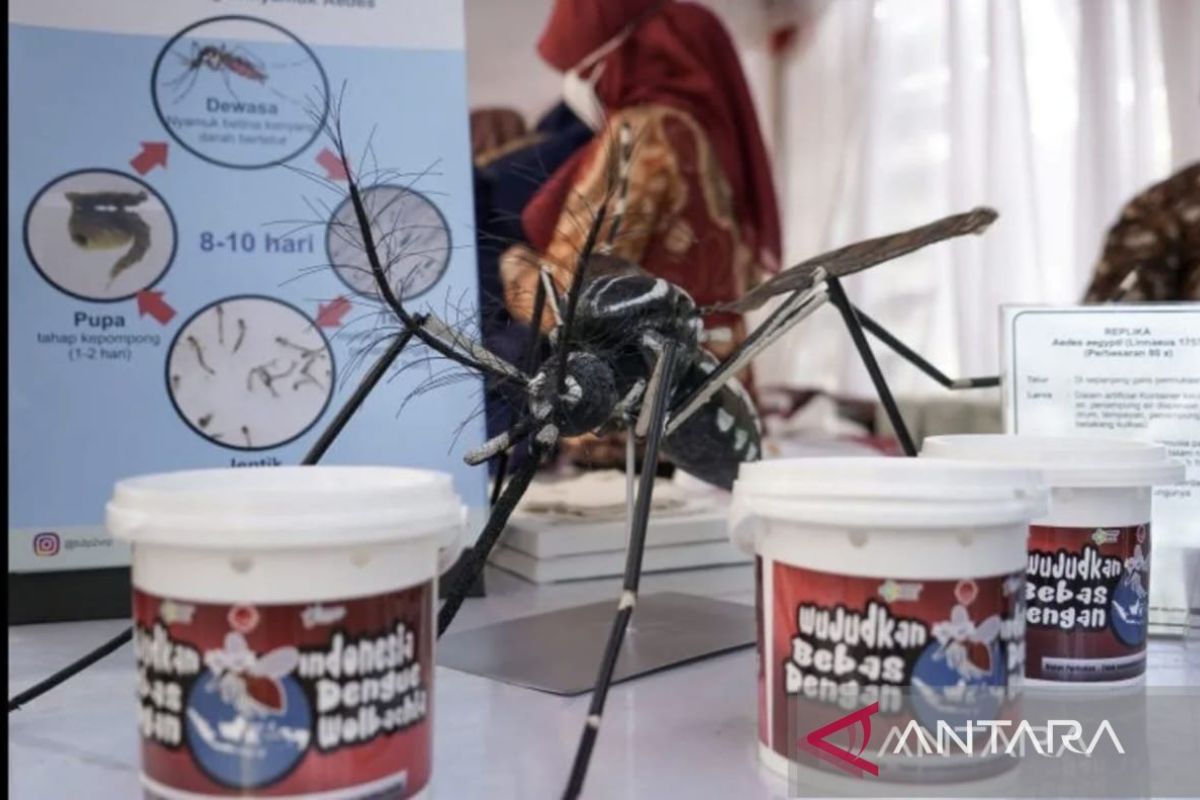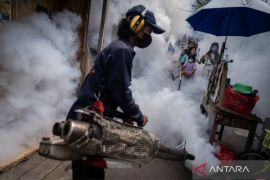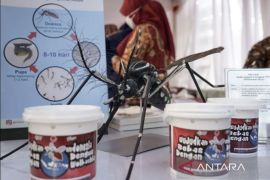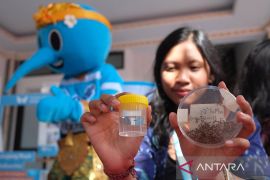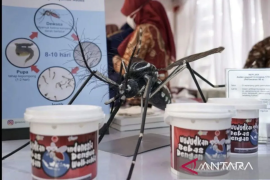The Ministry of Health reported that the highest incidence of deaths due to dengue had been found in people aged 5-14 years, with a case rate of around 50-60 percent.
Moreover, the outbreaks still occur in various regions in Indonesia, including West Java.
The Directorate General of Communicable Disease Prevention and Control of the Ministry of Health reported that from January to November 2023, some 76,449 dengue fever patients were recorded, with a death toll of 571.
The figure showed a decline as compared to the previous year, during which the number of patients reached 143,300 people, with a death toll of 1,236.
This has been achieved through the current interventions, comprising fogging, using larvicides, and implementing the 3M plus movement that includes cleaning water storage containers, covering water storage containers, and reusing or recycling used goods.
Nevertheless, alternative innovations are still needed to prevent and control dengue fever until the lowest level of cases in Indonesia as well as to accelerate the achievement of dengue fever elimination by 2030.
One of the newest forms of innovation currently applied in Indonesia is the use of the Wolbachia bacteria injected into cells in the body of the Aedes aegypti mosquito. This innovation has been proven effective in reducing the rate of dengue cases in 14 countries, including Brazil, Australia, and Singapore.
A researcher at the Center for Tropical Medicine of Gadjah Mada University (UGM), Adi Utarini, stated that the Wolbachia bacteria had been first discovered in the reproductive tissue of the Culex pipiens mosquito by Hertig and Wolbach in 1924, and the species was then named Wolbachia pipientis.
The Wolbachia method has gone through a lengthy research process in Indonesia, which began in 2011, starting from the trial of mosquito trapping in houses to receiving a recommendation from the World Health Organization (WHO).
Wolbachia is found in the bodies of six out of 10 types of insects in the world, including butterflies, fruit flies, and bees.
Research in Yogyakarta in 2012 conducted in five hamlets, including residential areas and agricultural areas in Sleman District and Bantul District, showed that Wolbachia pipientis was found in 44.9 percent of insects, such as butterflies, moths, mosquitoes, and flies.
The research also proved that Wolbachia bacteria do not infect humans or other vertebrates and do not cause humans or animals to fall sick, as they are obligate endosymbionts that can only live in the cells of living insect organisms.
Head of the Communication and Public Services Bureau at the Ministry of Health, Siti Nadia Tarmizi, explained that based on the research, Wolbachia can reduce the replication of the dengue virus in the body of the Aedes aegypti mosquito, thereby reducing the mosquito's vectorial capacity for dengue.
"The main working mechanism is through food competition between the virus and bacteria. With little food that can support the virus, the virus cannot reproduce," she explained.
Related news: Yogyakarta dengue cases drop with Wolbachia-infected mosquitoes
Mechanism
The research on Wolbachia conducted by the Center for Tropical Medicine of UGM along with Australia's Monash University through funding of the Tahija Foundation showed a 77.1-percent decline in dengue cases and 86.2-percent decline in inpatients in Yogyakarta.
Utarini explained that based on the research result, Wolbachia in Aedes aegypti mosquitos' cells would cause the dengue virus in mosquitos to not develop, so they are unable to transmit dengue fever to humans who are bitten.
There are three transmissions of Wolbachia in the Aedes aegypti mosquito. First, it occurs when a male mosquito with Wolbachia mates with a female mosquito with Wolbachia, so that the eggs hatch to mosquitos that contain Wolbachia.
The second type is when a male mosquito without Wolbachia mates with a female mosquito with Wolbachia, thereby producing mosquitos with Wolbachia. Third, it occurs when a male mosquito with Wolbachia mates with a female mosquito without Wolbachia, so the eggs will not hatch.
The Wolbachia method is carried out by using buckets filled with clean water, where each of the buckets contains 250 to 300 mosquito eggs, with an egg hatching rate of around 90 percent. Each bucket is placed at a distance of 75 square meters.
The minimum number of buckets must reach 10 percent of the Aedes aegypti population in the area, and the release should be conducted 12 times.
In Yogyakarta City, the method has been implemented for more than 10 years, and more than 1.5 million people live in areas where the release of clouds of mosquitos with Wolbachia took place. So far, there is no scientific evidence that the method is dangerous for the environment, humans, and animals' health.
Risk evaluations and studies have also been conducted, the results of which show that the method and benefits of Wolbachia can be expanded to help protect millions of people in Indonesia from dengue fever.
Related news: Need to raise public understanding of Wolbachia method benefits: Govt
Safety
Based on the research and promising results, the Ministry of Health then issued Health Minister's Decree Number 1341 of 2022 on the Implementation of the Pilot Project of Dengue Control through Wolbachia as one of the control strategies included in the national strategy for dengue prevention that is implemented in five cities: Semarang, West Jakarta, Bandung, Kupang, and Bontang.
The ministry, along with 25 Indonesian researchers, has ensured that the Wolbachia innovation has been proven safe based on risk analysis studies and effectiveness results from trials.
Results of the analysis were then reported to the WHO and finally, in 2021, the Wolbachia method was recommended by the WHO.
A researcher of mosquitos with Wolbachia at the Center for Tropical Medicine of UGM, Riris Andono Ahmad, denied the news that Wolbachia innovation was a result of genetic engineering that can potentially trigger the emergence of new diseases.
He believes that the innovation will not cause a change in the genetics of the Wolbachia bacteria in insect cells and the mosquitos.
"The analogy is that the Wolbachia bacteria are present in many insects and then introduced into the Aedes aegypti mosquito. It is similar to us consuming bacteria, such as probiotic milk. Once the bacteria that we drink enter our bodies, we do not become a genetically engineered human," he explained.
Those bacteria can only live inside insect cells, so if they leave their host, they will definitely die.
On account of the good results, the Ministry of Health then decided to expand the areas for releasing clouds of mosquitos with Wolbachia to West Jakarta, Bandung, Semarang, Bontang, and Kupang.
Despite having shown good results, implementation of the Wolbachia method still requires regular monitoring and evaluation to see the program's progress.
The Ministry of Health has issued a guidebook for controlling dengue in five cities by using the Wolbachia method to ensure the program runs well in accordance with the research conducted in Yogyakarta.
According to data from the Health Office of Yogyakarta City, in 2023, the city recorded 67 cases of dengue fever, which is its lowest figure in the last three decades.
Apart from reducing the number of dengue cases, the spread of mosquitos with Wolbachia is also said to have reduced the budget for handling dengue in Yogyakarta City.
One budget that can be reduced is that for fogging. In 2022, fogging was conducted 200 times, but in 2023, as of October, it has only been carried out nine times.
Related news: Disseminating information on Wolbachia method a challenge: official
Related news: Wolbachia effective in reducing dengue cases by 77%: ministry
Editor: Yuni Arisandy Sinaga
Copyright © ANTARA 2023
